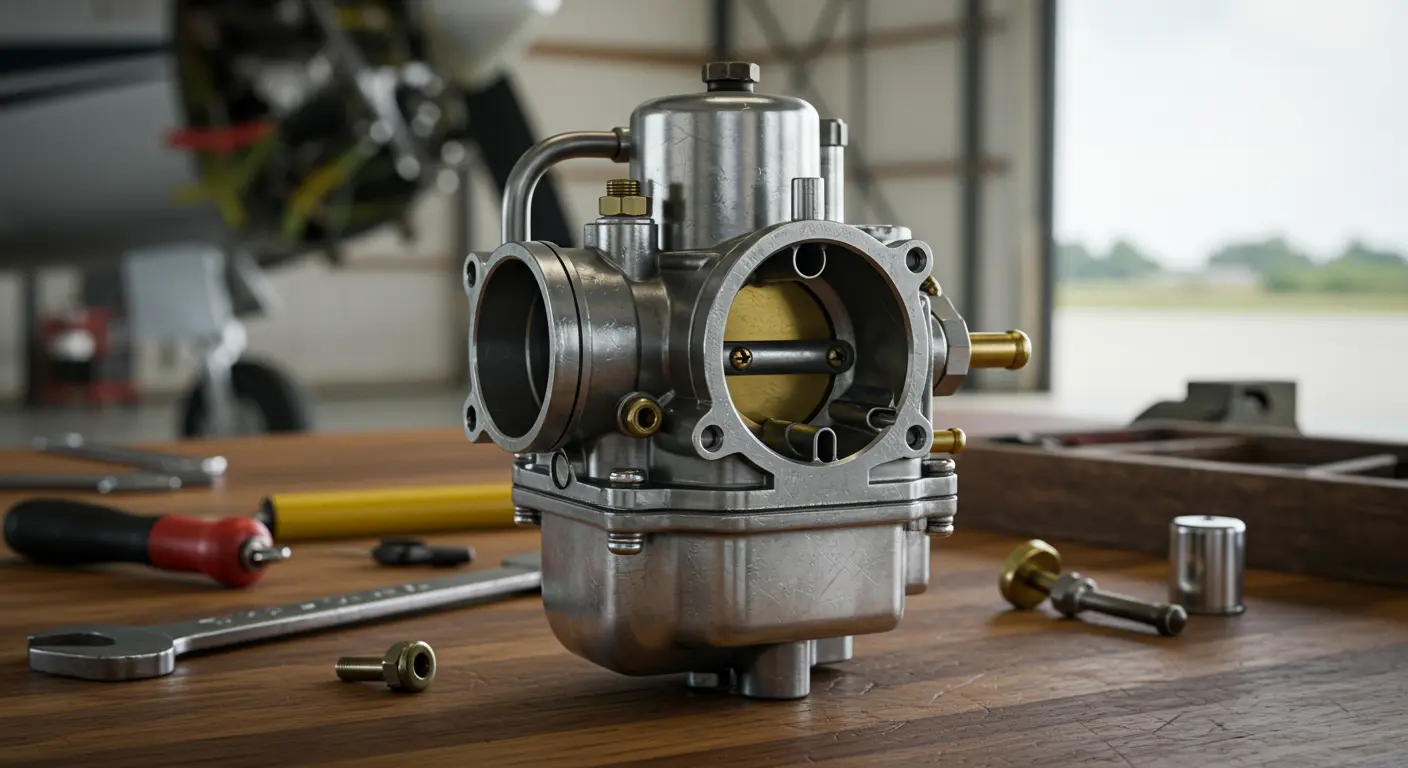Understanding Carburetor Icing: Causes, Symptoms, and Prevention
What is Carburetor Icing?
Carburetor icing represents a dangerous condition affecting float-type carburetors—particularly in aviation—where atmospheric moisture crystallizes on critical internal surfaces like the throttle valve. This ice buildup restricts the fuel-air mixture flow, reducing engine power.
Two physical processes cause this condition: the venturi effect dramatically reduces air pressure and temperature as airflow accelerates through the carburetor’s throat, while fuel evaporation simultaneously strips away additional thermal energy.
Carburetor icing occurs in conditions below 21°C (70°F) coupled with humidity exceeding 80%. Carburetor icing can occur even in relatively warm conditions, catching pilots off guard with escalating power loss—or worse, complete engine failure.
Causes of Carburetor Icing
-
Low power settings: Descent or slow flight scenarios reduce engine heat—diminished airflow means less engine-generated heat to combat ice formation.
-
Partial carburetor heat: This can worsen the problem: melted ice can refreeze on downstream components, making the ice blockage worse.
Air Pressure, Dew Point, and Icing
When carburetor temperatures plummet below the dew point, atmospheric moisture condenses into water droplets. Should temperatures continue their descent past the freezing threshold, these droplets crystallize onto internal surfaces—creating the very ice that threatens engine operation.
The dew point spread—that critical gap between ambient temperature and dew point—provides an important indicator. A narrow spread signals moisture-saturated air, where even minimal cooling can cause ice formation.
Careful weather monitoring is essential. Comprehensive weather briefings—scrutinizing temperature, humidity, and dew point data—enable operators to anticipate trouble, particularly in moisture-rich environments like coastal zones or post-precipitation conditions.
Evaporation of Fuel
Fuel evaporation creates additional cooling. As fuel transforms from liquid to vapor, it absorbs heat—the latent heat of vaporization—from surrounding carburetor components.
Symptoms of Carburetor Icing
Quick symptom recognition is critical for safety. As ice gradually restricts the fuel-air mixture, telltale signs emerge: gradual power erosion and increasingly erratic engine behavior.
Power Loss and Lower RPM
Power loss manifests differently depending on your propeller configuration. Fixed-pitch propeller pilots witness a telltale RPM decline at constant throttle settings—ice is literally choking off the fuel-air mixture.
Constant-speed propeller aircraft present a more subtle challenge. The initial warning appears as manifold pressure deterioration, not RPM changes.
What begins as gradual power loss escalates into a steady decline. Left unchecked, this progression culminates in complete engine failure—making early detection essential.
Rough Running and Vibration
As icing worsens, engines develop rough, vibration-plagued operation. Irregular ice formations create an uneven fuel-air mixture distribution, starving some cylinders while flooding others.
This cylinder-to-cylinder power imbalance generates vibrations that ripple through the entire airframe and flight controls. What begins as subtle tremors intensifies into unmistakable shaking as ice accumulation worsens.
The rough-running engine often shows signs of distress through erratic RPM swings and alarming acoustic signatures—popping, backfiring, and other sounds of combustion distress. These sensory warnings—both heard and felt—indicate the need for immediate action.
Preventing Carburetor Icing
The main defense against carburetor icing is the carburetor heat system—a system that channels warm air from the exhaust manifold directly into the carburetor’s throat. This heated airflow elevates internal temperatures, either preventing ice formation or melting existing accumulations.
Use carburetor heat preventively during high-risk conditions—waiting for symptoms may be too late. It is typically used at reduced power settings, such as during descent. Expect a temporary spike in engine roughness when applying heat—this is actually good news, indicating that melting ice is being purged from the system.
Beyond using carburetor heat, other preventive measures include:
-
Weather Awareness: Monitoring temperature, humidity, and dew point spread during pre-flight planning.
-
Power Management: Maintaining higher power settings when feasible and avoiding prolonged low-power operation to keep the engine warm.
Be Aware of Typical Icing Conditions
Be aware of geographic and meteorological factors that increase humidity and icing risk:
Fuel Mixture Adjustments
Strategic fuel mixture management provides additional protection against icing. During climb phases, decreasing air density naturally enriches the fuel-air mixture—potentially increasing carburetor cooling if left uncorrected.
Proper mixture leaning for altitude maintains optimal combustion temperatures, generating the heat needed to keep carburetor components warm. However, excessive leaning at high power settings risks engine damage—precision is paramount.
Master your aircraft’s specific leaning procedures, whether manual or automatic mixture controls. At lower altitudes where icing risk peaks, a slightly enriched mixture provides additional thermal protection by boosting combustion temperatures.
Conclusion
Carburetor icing is a serious but manageable threat for float-type carburetor operators. Mastering its root causes—temperature depression from venturi effects and fuel evaporation—forms the foundation of effective prevention.
The gradual progression from subtle power erosion to potential engine failure requires careful attention to symptoms. Recognizing early warning signs—declining RPM or rough engine operation—allows for timely carburetor heat application.
Comprehensive carburetor icing knowledge—encompassing causes, symptoms, and prevention—is essential safety knowledge for aviation professionals. Incorporating this knowledge into standard operating procedures significantly improves flight safety.







